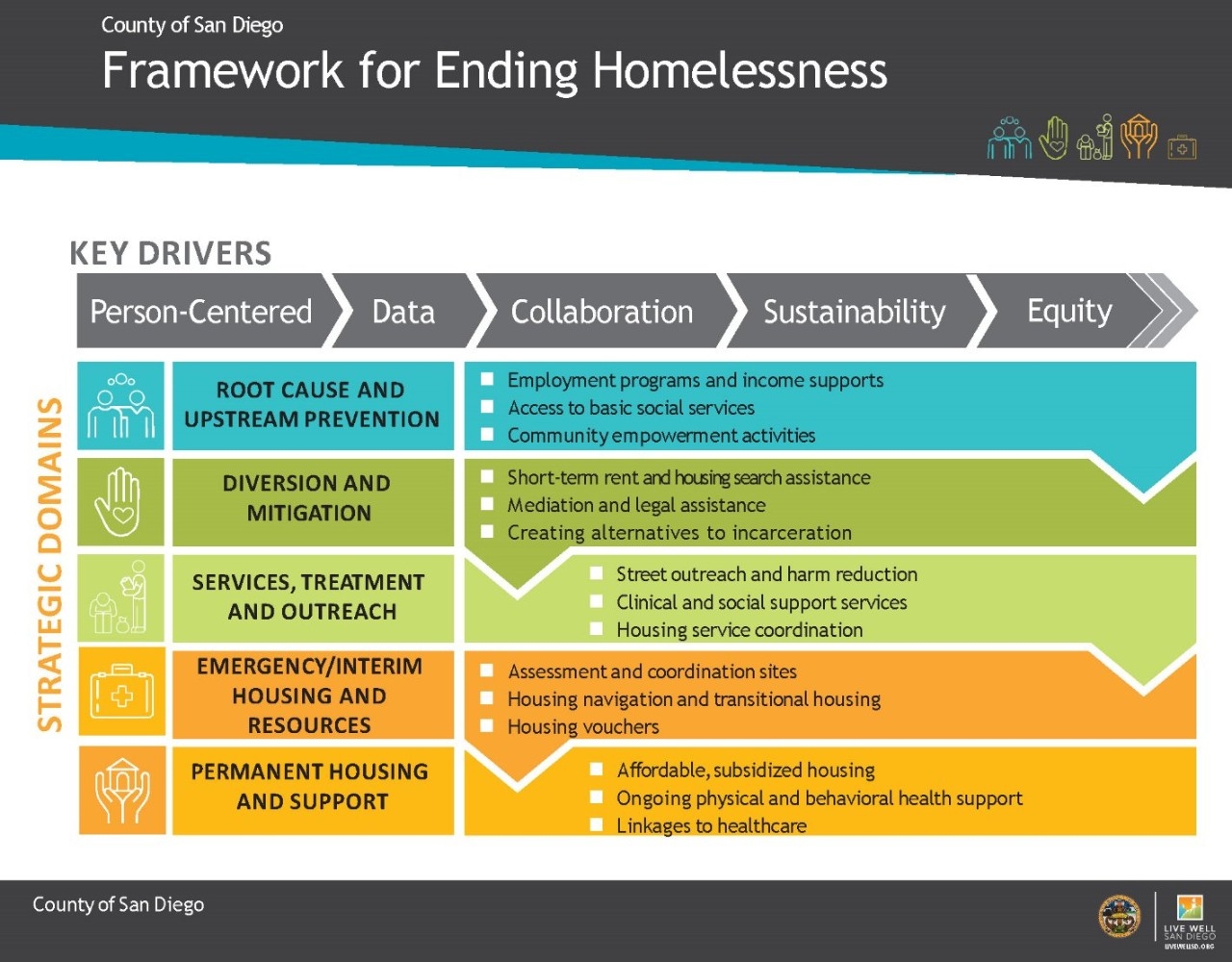Framework for Ending Homelessness

Framework for Ending Homelessness
The San Diego County Board of Supervisors is committed to efforts in providing housing and supportive services that address the needs of people experiencing or at-risk of homelessness and adopted the County’s Framework for Ending Homelessness in November 2021.
The Framework is anchored in five strategic domains and five key drivers that guide the County’s vision to support forward, collaborative and impactful progress.
The strategic domains represent the continuum of opportunities to end homelessness, by preventing it when possible, and reducing the length of time experienced, by strengthening ways to remain housed. The domains are:
- Root Causes and Upstream Prevention: This domain focused on addressing poverty, ensuring household stabilization and enrichment through employment programs and income supports, and access to basic social services and community empowerment activities.
- Diversion and Mitigation: This domain focuses on interventions that will prevent people who are on the brink of homelessness from becoming homeless, such as short-term rent assistance, mediation, housing search and connections, legal assistance, and creating alternatives to incarceration for persons experiencing homelessness.
- Services, Treatment and Outreach: This domain focuses on interventions that include street outreach, harm reduction, clinical, social and housing support services.
- Emergency/Interim Housing/Resources: This domain focuses on interventions for emergency and interim housing needs with assessment, supportive services coordination and housing navigation.
- Permanent Housing and Support: This domain focuses on providing permanent solutions to affordable housing and the support services individuals may need to maintain permanency.
Each of the Framework’s five strategic domains is driven by the following five key commitments that guide the County’s approach:
- Person-Centered Approach: The Person-Centered approach emphasizes the unique needs of each person to guide individualized supports and services that are created in culturally sensitive ways to address unique needs of various vulnerable populations including but not limited to LGBTQ+, older adults, veterans, foster youth, and justice involved individuals.
- Data: A data-driven approach is one that uses evidence-based policy making to create more effective, equitable and focused outcomes.
- Regional Collaboration: Collaborating across the geographic boundaries through partnerships with jurisdictions, services providers, community partners, stakeholders and others is crucial to aligning efforts to end homelessness.
- Sustainability: A sustainable approach is one that promotes and maintains solutions to ensure housing stability through a variety of financial investments.
- Equity: Equity is a priority of the County and therefore all aspects of homelessness prevention and response should ensure racial and social equity.
Homelessness Solutions and Prevention Action Plan
To advance Framework efforts into measurable priorities and outcomes, OHS developed the Homelessness Solutions and Prevention Action Plan to outline strategies to impact homelessness regionally and align them with existing efforts, County resources and authority, and the objectives of federal, State, regional, and local strategic plans. The Action Plan includes desired outcomes and progress milestones for each of the Framework's strategic domains, best practices, data analysis, and feedback collected from community engagement including input from people with lived experience of homelessness.
A scorecard to track the progress and milestones outlined in the Action Plan is currently under development, which will include a logic model and outcome results. The Action Plan scorecard will be posted once finalized.










